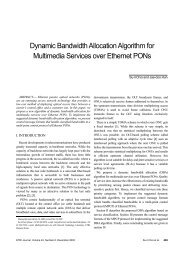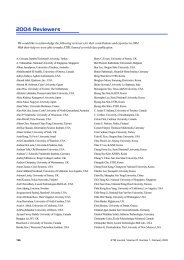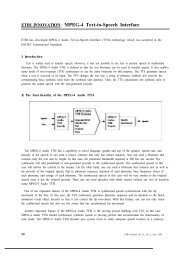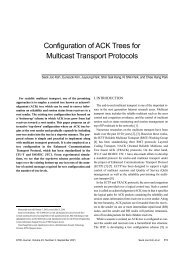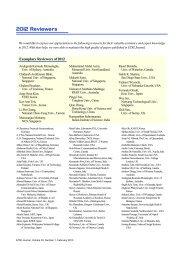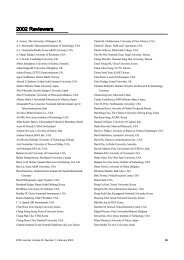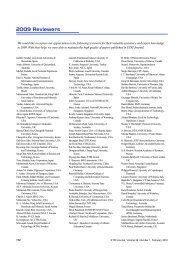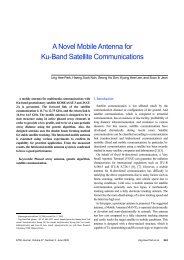Test-Generation-Based Fault Detection in Analog ... - ETRI Journal
Test-Generation-Based Fault Detection in Analog ... - ETRI Journal
Test-Generation-Based Fault Detection in Analog ... - ETRI Journal
You also want an ePaper? Increase the reach of your titles
YUMPU automatically turns print PDFs into web optimized ePapers that Google loves.
Table 7. Classification results of SVF us<strong>in</strong>g PNN with parametricfaults.M<strong>in</strong>imum fractionvariance (PCA)1%2%5%SpreadPNNCoif3%C %P %Q0.1 100 100 1000.2 100 100 1000.3 100 100 1000.1 100 100 1000.2 100 100 1000.3 100 100 1000.1 100 100 1000.2 100 100 1000.3 100 100 100Table 8. Comparison of results obta<strong>in</strong>ed us<strong>in</strong>g the pseudorandom andPWL methods.IEEE benchmark circuitsOperationalamplifierState variablefilterVI. ConclusionCatastrophic faultPseudorandommethodPWLmethodParametric faultPseudorandommethodPWLmethod100% 100% 94.5% 100%100% 100% 95% 100%In the proposed PWL-based test<strong>in</strong>g method, specificationdriven PWL stimulus is generated us<strong>in</strong>g a genetic algorithm.The conventional PWL generation method uses measurementsfrom multiple nodes <strong>in</strong> the circuit, whereas the proposed PWLgeneration method takes only the output node measurements.This is a very important feature of the proposed method. Whenthe circuits were tested with generated PWL signal, it wasfound that the proposed method achieves 100% fault coveragefor catastrophic faults and parametric faults present <strong>in</strong> <strong>Analog</strong>VLSI circuits.References[1] V.N. Pramodchandran and A. Chatterjee, “<strong>Test</strong> <strong>Generation</strong> forComprehensive <strong>Test</strong><strong>in</strong>g of L<strong>in</strong>ear <strong>Analog</strong> Circuits Us<strong>in</strong>gTransient Response Sampl<strong>in</strong>g,” Int’l Conf. on Computer AidedDesign, 1997, pp. 382-385.[2] V.N. Pramodchandran and A. Chatterjee, “Specification-Driven<strong>Test</strong> Design for <strong>Analog</strong> Circuits,” IEEE Int’l Symp. on Defect and<strong>Fault</strong> Tolerance <strong>in</strong> VLSI Systems, 1998, pp. 335-340.[3] P. Kalpana and K. Gunavathi, “Specification <strong>Based</strong> <strong>Test</strong> Pattern<strong>Generation</strong> Us<strong>in</strong>g Genetic Algorithm and Wavelets,” Int’l Conf.on VLSI Design, 2005, pp. 504-507.[4] S.S. Somayajula, E. Sanchez-S<strong>in</strong>encio, and Gyvez, “<strong>Analog</strong> <strong>Fault</strong>Diagnosis <strong>Based</strong> on Ramp<strong>in</strong>g Power Supply Current SignatureClusters,” IEEE Trans. on Circuits and Systems–II, vol. 43, 1996,pp. 703-712.[5] Z.R. Yang et al., “Apply<strong>in</strong>g a Robust Heteroscedastic ProbabilisticNeural Network to <strong>Analog</strong> <strong>Fault</strong> <strong>Detection</strong> and Classification,”IEEE Trans. on CAD, vol. 19, no. 1, 2001, pp. 142-151.[6] F. Am<strong>in</strong>ian and M. Am<strong>in</strong>ian, “<strong>Fault</strong> Diagnosis of <strong>Analog</strong> CircuitsUs<strong>in</strong>g Bayesian Neural Networks with Wavelet Transform asPreprocessor,” J. of Electronic <strong>Test</strong><strong>in</strong>g, vol. 17, 2001, pp. 29-36.[7] F. Am<strong>in</strong>ian, M. Am<strong>in</strong>ian, and H.W. Coll<strong>in</strong>s, “<strong>Analog</strong> <strong>Fault</strong>Diagnosis of Actual Circuits Us<strong>in</strong>g Neural Networks,” IEEETrans. on Instrumentation and Measurement, vol. 51, no. 3, 2002,pp. 544-550.[8] P. Kalpana and K. Gunavathi, “Wavelet <strong>Based</strong> <strong>Fault</strong> <strong>Detection</strong> <strong>in</strong><strong>Analog</strong> VLSI Circuits Us<strong>in</strong>g Neural Networks,” Applied SoftComput<strong>in</strong>g <strong>Journal</strong>, 2008, pp. 1592-1598.Palanisamy Kalpana received her BE degree<strong>in</strong> electronics and communication eng<strong>in</strong>eer<strong>in</strong>g,and her ME degree <strong>in</strong> applied electronics, <strong>in</strong>1992 and 2002, respectively, from PSG Collegeof Technology, Coimbatore, India. She iscurrently work<strong>in</strong>g as an assistant professor <strong>in</strong>the ECE Department of the PSG College ofTechnology. Her research <strong>in</strong>terests <strong>in</strong>clude ASIC design, CAD ofVLSI design, reconfigurable comput<strong>in</strong>g and test<strong>in</strong>g of digital, analog,and mixed signal VLSI circuits.Kandasamy Gunavathi received the BEdegree <strong>in</strong> electronics and communicationeng<strong>in</strong>eer<strong>in</strong>g, the ME degree <strong>in</strong> computer scienceand eng<strong>in</strong>eer<strong>in</strong>g, and the PhD <strong>in</strong> 1985, 1989,and 1998, respectively, from PSG College ofTechnology, Coimbatore, Tamil Nadu, India.Her research <strong>in</strong>terests <strong>in</strong>clude low-power VLSIdesign, as well as design and test<strong>in</strong>g of digital, analog, and mixedsignal VLSI circuits. She is currently work<strong>in</strong>g as a professor with theECE department of PSG College of Technology. She has around 20years of teach<strong>in</strong>g and research experience and is a life member of ISTE.She has published papers <strong>in</strong> 20 national and <strong>in</strong>ternational journals and60 national and <strong>in</strong>ternational conference publications.214 Palanisamy Kalpana et al. <strong>ETRI</strong> <strong>Journal</strong>, Volume 31, Number 2, April 2009




